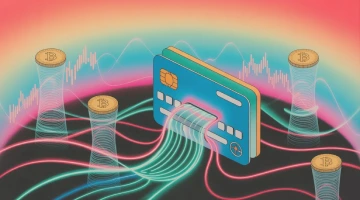Multi-Chain vs. Cross-Chain Project Development

The blockchain landscape is evolving rapidly, marked by the coexistence of multi-chain project development and cross-chain project development technologies. As the Web3 ecosystem spans hundreds of blockchains, layer-2 networks, and appchains, the need for seamless communication between these disparate systems becomes increasingly vital. In this article, we'll explore the concepts of multi-chain project development and cross-chain project development, highlighting the significance of each in addressing the challenges of blockchain fragmentation and understanding the differences between them.
What Is Multi-Chain Development?
Multi-chain project development describes the ecosystem of numerous blockchains that exist today. However, it's more commonly associated with blockchain applications launching on multiple blockchains, often referred to as multi-chain applications.

How Does Multi-Chain Work?
Multi-chain project development is a response to blockchain fragmentation, where each blockchain operates as an isolated entity with limited connectivity to other blockchains or external systems. In multi-chain project development, developers set up separate, isolated instances of smart contracts for each blockchain. The goal is to expand the user base by accommodating users on various blockchain environments. For instance, a user familiar with one blockchain can access a multi-chain project development without the hassle of switching networks, downloading new wallets, or bridging funds.
Problems With Multi-Chain Development
While multi-chain project development offers a solution for broadening user reach, it comes with its own set of challenges, including a significant technical burden. Developers must adapt their code to meet the specific requirements of each blockchain, maintain multiple instances, and ensure security. Additionally, multi-chain project development tends to remain within specific ecosystems to reduce complexity.
Examples of Multi-Chain Projects
Multi-chain technology is becoming increasingly prevalent in the blockchain and cryptocurrency space, with various projects and platforms working on enabling interoperability between different blockchains. Here are some examples of Multi-chain projects and solutions:

- Balancer (Multi-Chain Pools): Balancer is an automated portfolio manager and decentralized exchange protocol. It offers multi-chain pools, allowing users to create and manage liquidity pools on various blockchains, enhancing capital efficiency and asset management.
- Nifty Gateway (Multi-Chain NFT Platform): Nifty Gateway is an NFT marketplace that operates on multiple blockchains. It supports NFT creation, trading, and auctioning on chains like Ethereum and Flow. This multi-chain approach provides artists and collectors with flexibility in choosing where to mint and trade their NFTs.
- Decentraland (Multi-Chain Virtual World): Decentraland is a virtual world built on the Ethereum blockchain. While primarily on Ethereum, it uses multi-chain integrations to enable interaction and interoperability. This multi-chain integration enhances the virtual world's functionality and user experience.
- Uniswap (Multi-Chain Support): Uniswap, a leading decentralized exchange (DEX), has extended its services to operate on multiple blockchains. While its core platform is on Ethereum, Uniswap has expanded to other chains, such as Polygon, to provide liquidity and trading options on various networks.
These examples showcase the growing importance of multi-chain technology in the blockchain industry.
What Is Cross-Chain Development?
Cross-chain project development involves the capability to transfer data and tokens between different blockchains. As web3 project development becomes popular, the challenge lies in enabling these distinct on-chain environments to interoperate and communicate effectively.

Why Is Cross-Chain Communication Important?
Cross-chain project development plays a pivotal role in achieving a more integrated Web3 ecosystem. By facilitating cross-chain project development, these solutions reduce fragmentation and enhance capital efficiency and liquidity conditions. They enable the composability of complex applications, as developers can combine dApp development into a single structure that can achieve more than the sum of its parts.
How Does Cross-Chain Technology Work?
Cross-chain development solutions typically involve validating the state of the source blockchain and relaying transactions to the destination blockchain. A crucial component is the cross-chain bridge, which allows tokens to move between source and destination blockchains. Programmable token bridges enable more complex cross-chain project development, while data messaging protocols support the creation of advanced cross-chain applications such as decentralized exchanges, NFT platforms, and more.
For more info about Cross-Chain Development solutions visit our guide: 10 Reasons Why Your Coin Needs a Cross-Chain Bridge
Challenges of Cross-Chain Solutions
Cross-chain solutions development presents unique challenges compared to the multi-chain project development approach. It requires careful consideration of security, trust, and flexibility trade-offs. Weak security in cross-chain project development can expose funds to vulnerabilities. Ensuring finality, or the availability of funds on the destination chain, is another critical consideration to prevent adverse consequences due to source chain transactions being reversed.
Examples of cross-chain projects

- Synthetix (Cross-Chain Asset Platform): Synthetix is a cross-chain DeFi platform that enables the creation and trading of synthetic assets on various blockchains, including Ethereum and Binance Smart Chain (BSC). It leverages cross-chain bridges and protocols to ensure synthetic assets remain interoperable and accessible across different blockchain networks.
- Chainlink (Cross-Chain Data Oracle): Chainlink is a widely recognized cross-chain project that provides decentralized data oracles to various blockchains, including Ethereum, Binance Smart Chain, and more. It facilitates the secure and reliable transfer of real-world data across different chains, supporting smart contracts and dApps on multiple platforms.
- Wormhole (Interoperability Protocol): Wormhole is a cross-chain interoperability protocol that connects different blockchain ecosystems, allowing assets and data to move between them. It operates on blockchains like Ethereum, Binance Smart Chain, and Solana, enabling users to connect with assets across these networks.
These examples showcase the growing importance of cross-chain technology in the blockchain industry. They offer solutions for improving interoperability, enabling the transfer of assets and data across different blockchains, and enhancing the overall functionality and efficiency of the blockchain ecosystem.
Scaling Web3 Via Secure Cross-Chain Apps
Cross-chain project development is a fundamental component of the next generation of Web3 unlocking new use cases and enhancing user experiences. It accelerates Web3 adoption, enabling developers to create sophisticated dApps accessible through traditional user interfaces and empowering various entities to access on-chain environments securely.
In conclusion, the blockchain ecosystem is marked by both multi-chain project development and cross-chain project development, each offering unique solutions to the challenges of blockchain fragmentation. These technologies are essential for achieving a more integrated and efficient Web3 ecosystem, driving innovation, and enhancing user experiences.
Differences Between Multi-Chain and Cross-Chain
The distinction between multi-chain project development and cross-chain project development lies in their technical implementation. Multi-chain project development has isolated smart contracts on each blockchain, while cross-chain project development employs a unified set of smart contracts that seamlessly communicate across different blockchains. The vision is to create applications that work natively across various blockchains, reducing the need for multiple individual deployments.

Cross-Chain Projects:
- Primary Focus: Cross-chain projects primarily emphasize achieving blockchain interoperability, making different blockchains work together seamlessly.
- Functionality: Their core functionality revolves around enabling communication, data sharing, and cross-chain transactions between independent blockchains within their ecosystem.
- Ecosystem: Cross-chain projects act as bridges, fostering an interconnected ecosystem where separate blockchains interact, share data, and collaborate effectively.
- Use Cases: These projects are best suited for applications that demand the transfer of assets and data between distinct blockchains, such as DeFi platforms and decentralized exchanges relying on cross-chain functionality.
Multi-Chain Projects:
- Primary Focus: Multi-chain projects focus on providing their services or applications on multiple chains, catering to various blockchain networks.
- Functionality: Their primary function is to extend their services, applications, or smart contracts to operate on different blockchain networks, offering the same features across multiple chains.
- Ecosystem: Multi-chain projects offer their services on various chains, yet they may not inherently enable full interoperability between these chains within their integrated ecosystem.
- Use Cases: They are suitable for applications that require consistent functionality or services across multiple blockchain networks. However, it's essential to understand that these functionalities may not inherently communicate or share data between the chains.
Conclusion
Choosing between multi-chain and cross-chain project development depends on specific use cases and requirements. Cross-chain project development is preferable in certain situations:
- Complex Interactions Across Blockchains: When your project involves intricate interactions between different blockchains, such as swapping, lending, staking, or complex financial operations, cross-chain development is more suitable. It allows for seamless communication and data transfer between various blockchain networks.
- Composability and Integration: If you aim to create a project that leverages the composability of different decentralized applications and requires integration with multiple blockchains, cross-chain development provides the flexibility to achieve this. It eliminates the need for deploying separate instances of the project on different networks.
- Enhanced User Experience: Cross-chain solutions can offer a superior user experience by allowing users to access and utilize a variety of blockchain networks without the need to switch wallets, bridge funds, or adjust to different environments. This is especially important when targeting a broad user base.
- Liquidity and Capital Efficiency: Cross-chain projects can optimize liquidity conditions and enhance capital efficiency by enabling users to access assets and markets on different blockchains seamlessly. This is particularly relevant in DeFi applications.
- Security Considerations: If the security of cross-chain interactions is a primary concern, choosing a well-designed cross-chain solution with strong security features can be advantageous. Cross-chain bridges and protocols have been developed with a focus on security to protect user assets.
- Preventing Fragmentation: Cross-chain development helps prevent fragmentation of liquidity and user activity across different blockchains. It can lead to a more unified and efficient ecosystem, which is especially valuable for projects that rely on network effects.
In summary, cross-chain project development is preferable when your project involves complex interactions, aims to provide enhanced user experiences, focuses on composability and integration, and requires optimized liquidity and capital efficiency. It is also a suitable choice when security and preventing network fragmentation are top priorities. However, the choice between multi-chain and cross-chain should be based on a careful analysis of your project's specific requirements and objectives.
We ❤️ Development
Follow us on social media to receive the hottest blockchain development updates
Crunchbase ⚡️ Twitter ⚡️ Telegram ⚡️ LinkedIn ⚡️ Facebook ⚡️ Zupyak ⚡️ Quora ⚡️ Reddit













%201.webp)



